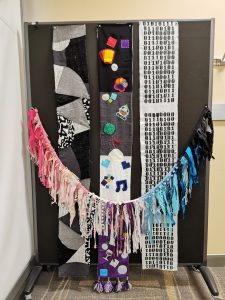Encoded Cloth – Leilani & Amber
We decided to make a series of hanging scarfs, as a representation of asexuality and bisexuality, two identities that we respectively identify with. We wanted to use the colors of the two pride flags, as well as symbolism from our lives, to show that even though sexuality is something that is present in our lives, that we also have identities that exist outside of it.
Leilani: For my portion, I first block printed a white fabric using 4 blocks of 01, 11, 10, and 00, to represent in binary a quote that says “We are the chick. The world is our egg.” This quote is from the anime Utena, which expresses the sentiment that we have to see beyond our world, to destroy gender norms and ideas of sexuality, so that we can bring revolution. I then matched it with a patchwork appliqué scarf, using black, grey, and white as colors, to represent different parts of my life all coming together, to create who I am as a person. The choice of colors was intentional, to match the monochrome parts of Amber’s scarf, but also because I tend to dress in greys, which would make the scarf better match my aesthetic and therefore be functional.
Amber: For my portion, my goal was to showcase different aspects of my life that have meaning for me outside of the societal expectations for finding that “one true love.” I originally wanted to have the four different sections of the flag being different aspects like family, friends, interests, etc, but as I was going through the process I realized how many of these other concepts were too abstract for what I wanted for the project. I decided to do symbolism patches for some of my close friends, birthstone patches for my family, and encoding the phrase “relationship anarchy” in binary. My process included hand-sewing and embroidering the individual patches, constructing the flag background, and then hand-sewing the patches onto the piece and embroidering the binary. I chose the colors and materials especially to contrast the monotone backdrop of the asexual flag.
Throughout this process, we both gained an appreciation for other’s experiences with sexuality. Since our project was so based on personal experience with the topic, we both had the opportunity to view the important aspects from other perspectives. This project also solidified our combined skills in machine sewing, appliqué, and block printing. From the critique, we saw the perceived connection between our topic of sexuality and others’ readings of gender. While this connection is something we considered playing around with earlier in development, seeing people’s reading of gender even when we did not intentionally include it added to our overall topic of identity as a whole. If we were to continue with the project, we would want to add more symbolic and binary elements to further the piece.
